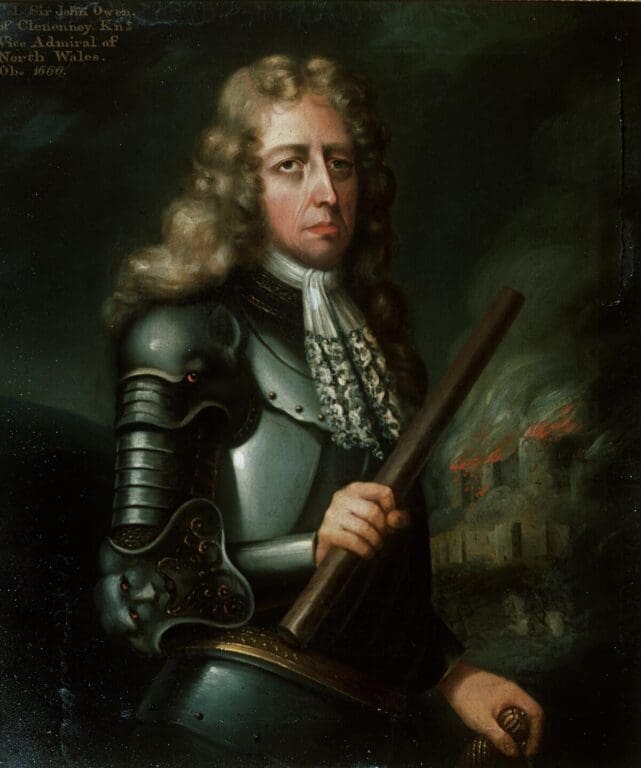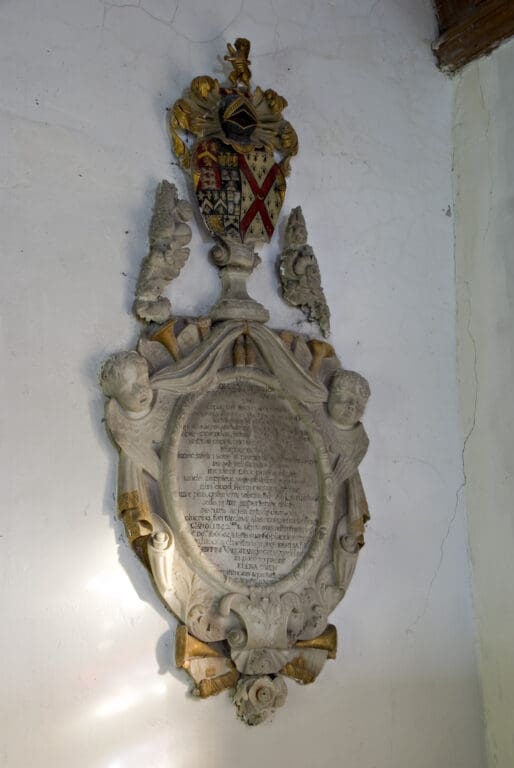
Published: 24/04/2019
Updated: 24/08/2022
Dr John Morgan Guy is Honorary Research Fellow at the Roderic Bowen Library and Archives of the University of Wales Trinity Saint David, Lampeter and a trustee of the Friends of Friendless Churches. In 2019, in celebration of the Visit Wales ‘Year of Discovery’, John explored stories of fascinating people connected with our churches. In this blog he looks at Sir John Owen, a 17th century figure of intrigue and power, who is buried at our church at Penmorfa, in Gwynedd.

There is a touch of Alexandre Dumas’ D’Artagnan about Sir John Owen. He was born in 1600 at Clenennau estate, in the Caernarfonshire parish of Dolbenmaen.
The current house at Clenennau was built by Sir John in about 1662 to replace his birthplace, which had suffered in the Civil War. Clenennau was once one of the most important estates in the county, but sadly little now remains of the house, or of its successor. John Owen came from a wealthy family; his father had made his fortune as secretary to Queen Elizabeth’s spymaster, Sir Francis Walsingham, and when Sir John inherited Clenennau from his mother in 1626, he became one of the richest men in this part of Wales.
Leading Royalist North-West Wales in the Civil War
Whilst tensions rose between King Charles I and his Parliament – tensions which finally erupted into civil war in 1642 – Owen proved himself a loyal servant of his monarch, probably in some kind of military service, in which he must have distinguished himself, otherwise, as Professor Ronald Hutton remarked,
‘it is hard to see why he should have been singled out in September 1642 to command the foot regiment to be raised in north-west Wales for the king’s service.’
Singled out he was: Owen led from the front and commanded his regiment with distinction, and at the storming of Bristol in July 1643, he was wounded in the face. Later he was to serve as governor of Reading, and then, as governor of Conway, had responsibility for all the royal forces in north-west Wales. It was here that he held off the Parliamentary forces until the autumn of 1646 when he was blockaded in the castle, finally surrendering in the November.
Wounded, Tried for Treason, Sentenced to Beheading (twice!)…
A quiet life, however, was not for him. When Civil War erupted in 1648 he was in action again – only to be wounded, dragged from his horse and captured in a small-scale battle at Llandegai.
He was then tried for treason in March 1649, and in the aftermath of the execution of the king, sentenced again to beheading. Extraordinarily, by the narrowest of margins – just 5 votes – parliament quashed the sentence, and with a fine of £1000, Owen went back to his estates.
However, he remained under suspicion – he was a dangerous man, and was twice more imprisoned during Oliver Cromwell’s rule. Undeterred, in 1659, during the faltering Protectorate of Oliver’s ineffective son Richard, John Owen was again foremost in attempting to raise north-west Wales against the government. But the rising failed, his estates were seized, and he himself was a fugitive – saved only from penury and an almost certain death-sentence if captured, by the fall of the republic and the triumphant return of Charles II.
Thereafter he lived quietly at Clenennau and when he died in 1666, John Owen was buried in Penmorfa Church, which came into the care of the Friends in 1999.
Visit Penmorfa to marvel at Sir John’s elaborate memorial (pictured right) – an alabaster cartouche, the work of Robert Wynne of Ruthin, erected c.1700 by his granddaughter. In elegant, if somewhat flowery Latin, she records his eventful life (a translation is provided below):
“To the sacred memory of JOHN OWEN, of CLENNENAU, Caernarvonshire, Soldier, a man possessed of a burning love to his Country, and having an undoubted and evident loyalty to his King (The Blessed Martyr, Charles I); a Man who gladly faced the greatest possible dangers in order to rescue His Most Sacred Majesty from the fury of Traitors. This outstanding Man routed and broke up several times the force of the enemy and defended Religion, until, by an unhappy mischance, he fell into the hands, now steeped in Royal blood, of desperate men. From which predicament – surrounded by his foes – he could, by a craven petition, have secured his Freedom, but for the fact that, being, by the most perfect heroism, more concerned for his reputation than his life, he found such a double-role repellant. Therefore, undaunted, he offfard his neck to his Captors, but the Power of God turned back the sharp edge of the Executioner’s axe, and impeded the flight of Swift Fate, until, as an old man, he had seen with much joy, CHARLES II restored both to himself and to his Own.
He died peacefully in the Year of Our Lord 1666, and in the sixty-sixth year of his life, and HERE HE RESTS IN PEACE WITH HIS MOST DEAR WIFE, JANET, the daughter of GRIFFITH VAUGHAN, Knight, of Gors-y-Gedol.
ELENA (HELEN) OWEN, prompted by gratitude and filial affection has placed (this monument) to her Grandfather and Grandmother of Blessed Memory.”
It is from this memorial, and from his own papers, which he carefully preserved, that we know what we do about ‘this outstanding man’ – a Welsh Musketeer!

Alabaster cartouche to Sir John Owen

Learn more about Sir John Owen: